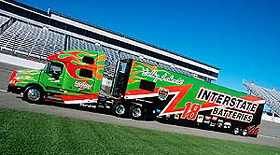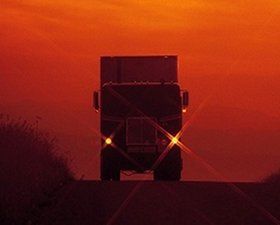What Is The Real Effect Or Benefit Of Double Clutching?
Topic 4123 | Page 1

Double clutching is the recommended practice by the transmission makers. While in gear the transmissions has the entire 80,000 lbs on the gears and clutching releaves the pressure on the gears before shifting. So yes there is a reason behind double clutching and millions of dollars in testing and research. Very sound reasoning.
But after time floating the gears is easier on the driver and if done correctly just as easy on the transmission as double clutching. Don't try and argue and reason with a shop or company about double clutching cause you will not make any friends doing it.
Now for schooling purposes it's not the company or school that is making you do it. It's the DOT and the testing procedures that say you have to double clutch during testing. It's just something that you have to do and once you get your own truck you are free to shift how you choose to at that point.
DOT:
Department Of Transportation
A department of the federal executive branch responsible for the national highways and for railroad and airline safety. It also manages Amtrak, the national railroad system, and the Coast Guard.
State and Federal DOT Officers are responsible for commercial vehicle enforcement. "The truck police" you could call them.
Double Clutch:
To engage and then disengage the clutch twice for every gear change.
When double clutching you will push in the clutch, take the gearshift out of gear, release the clutch, press the clutch in again, shift the gearshift into the next gear, then release the clutch.
This is done on standard transmissions which do not have synchronizers in them, like those found in almost all Class A trucks.
Double Clutching:
To engage and then disengage the clutch twice for every gear change.
When double clutching you will push in the clutch, take the gearshift out of gear, release the clutch, press the clutch in again, shift the gearshift into the next gear, then release the clutch.
This is done on standard transmissions which do not have synchronizers in them, like those found in almost all Class A trucks.
OOS:
When a violation by either a driver or company is confirmed, an out-of-service order removes either the driver or the vehicle from the roadway until the violation is corrected.
Dan, the gears in the transmission are spinning when the clutch is engaged, and they need to be spinning at the proper rpm for them to mesh together - they are not synchronized like a car's standard transmission. When you double clutch you are basically re-engaging the clutch briefly in between the two gears that you are shifting so that you are hopefully bringing the gears back up to the proper rpm for them to engage smoothly. I think that would be the simplest way to explain the function of double clutching without getting real technical on you.
Double Clutch:
To engage and then disengage the clutch twice for every gear change.
When double clutching you will push in the clutch, take the gearshift out of gear, release the clutch, press the clutch in again, shift the gearshift into the next gear, then release the clutch.
This is done on standard transmissions which do not have synchronizers in them, like those found in almost all Class A trucks.
Double Clutching:
To engage and then disengage the clutch twice for every gear change.
When double clutching you will push in the clutch, take the gearshift out of gear, release the clutch, press the clutch in again, shift the gearshift into the next gear, then release the clutch.
This is done on standard transmissions which do not have synchronizers in them, like those found in almost all Class A trucks.

I'm certainly not in any position to question or argue with anyone about double clutching. I'm just trying to understand the concept behind it. I understand that the weight of the vehicle is on the gears while in-gear; but, I was uncertain of the reason for 'releasing and re-clutching' before going into another gear. I know that RPMs must be brought up to speed when down-shifting but, is it any more necessary to double clutch while UP-shifting as opposed to DOWN-shifting (aside from DOT and mfg. requirements), or is it equally important for both up and down? I appreciate all your time in helping me understand this. Thanx!
DOT:
Department Of Transportation
A department of the federal executive branch responsible for the national highways and for railroad and airline safety. It also manages Amtrak, the national railroad system, and the Coast Guard.
State and Federal DOT Officers are responsible for commercial vehicle enforcement. "The truck police" you could call them.
Double Clutch:
To engage and then disengage the clutch twice for every gear change.
When double clutching you will push in the clutch, take the gearshift out of gear, release the clutch, press the clutch in again, shift the gearshift into the next gear, then release the clutch.
This is done on standard transmissions which do not have synchronizers in them, like those found in almost all Class A trucks.
Double Clutching:
To engage and then disengage the clutch twice for every gear change.
When double clutching you will push in the clutch, take the gearshift out of gear, release the clutch, press the clutch in again, shift the gearshift into the next gear, then release the clutch.
This is done on standard transmissions which do not have synchronizers in them, like those found in almost all Class A trucks.

I'm certainly not in any position to question or argue with anyone about double clutching. I'm just trying to understand the concept behind it. I understand that the weight of the vehicle is on the gears while in-gear; but, I was uncertain of the reason for 'releasing and re-clutching' before going into another gear. I know that RPMs must be brought up to speed when down-shifting but, is it any more necessary to double clutch while UP-shifting as opposed to DOWN-shifting (aside from DOT and mfg. requirements), or is it equally important for both up and down? I appreciate all your time in helping me understand this. Thanx!
The simple answer is yes it is equally important for up shifting and down shifting.
DOT:
Department Of Transportation
A department of the federal executive branch responsible for the national highways and for railroad and airline safety. It also manages Amtrak, the national railroad system, and the Coast Guard.
State and Federal DOT Officers are responsible for commercial vehicle enforcement. "The truck police" you could call them.
Double Clutch:
To engage and then disengage the clutch twice for every gear change.
When double clutching you will push in the clutch, take the gearshift out of gear, release the clutch, press the clutch in again, shift the gearshift into the next gear, then release the clutch.
This is done on standard transmissions which do not have synchronizers in them, like those found in almost all Class A trucks.
Double Clutching:
To engage and then disengage the clutch twice for every gear change.
When double clutching you will push in the clutch, take the gearshift out of gear, release the clutch, press the clutch in again, shift the gearshift into the next gear, then release the clutch.
This is done on standard transmissions which do not have synchronizers in them, like those found in almost all Class A trucks.

Dan, the function of "double clutching" is the same going up or down in the gear pattern: since the gears are not synchronized like a small truck or car, the act of releasing the clutch while in neutral helps to spin ALL the gears so that they "mesh" better. Keep in mind, though, the proper RPM of the engine in relation to the truck speed is still the deciding factor whether the gears go together smoothly or with a "clash." Like GuyJax said, once you are in your own truck you will be free to "float" the gears if that's how you want to shift. I still have to double clutch for another 40,000 miles as I am still on my trainer's truck and he wants to see me do so. Good Luck.
Jopa

Double Clutch:
To engage and then disengage the clutch twice for every gear change.
When double clutching you will push in the clutch, take the gearshift out of gear, release the clutch, press the clutch in again, shift the gearshift into the next gear, then release the clutch.
This is done on standard transmissions which do not have synchronizers in them, like those found in almost all Class A trucks.
Double Clutching:
To engage and then disengage the clutch twice for every gear change.
When double clutching you will push in the clutch, take the gearshift out of gear, release the clutch, press the clutch in again, shift the gearshift into the next gear, then release the clutch.
This is done on standard transmissions which do not have synchronizers in them, like those found in almost all Class A trucks.

There are many ways to shift a truck and double clutching in one way which I do sometimes because I am bored. I float the gears. I also clutch out and float into gear. I also speed shift the gears when needed. I use progressive shifting. I also double up and double down gears when shifting. It really is true in trucking when they say you lose what you don't use. I don't need 6 ways to shift a truck but depending on the circumstances and the terrain and weight of the load each shifting method make the truck more drivable or easier to drive.
Float The Gears:
An expression used to describe someone who is shifting gears without using the clutch at all. Drivers are taught to "Double Clutch" or press and release the clutch twice for each gear shift. If you're floating gears it means you're simply shifting without using the clutch at all.
Double Clutch:
To engage and then disengage the clutch twice for every gear change.
When double clutching you will push in the clutch, take the gearshift out of gear, release the clutch, press the clutch in again, shift the gearshift into the next gear, then release the clutch.
This is done on standard transmissions which do not have synchronizers in them, like those found in almost all Class A trucks.
Double Clutching:
To engage and then disengage the clutch twice for every gear change.
When double clutching you will push in the clutch, take the gearshift out of gear, release the clutch, press the clutch in again, shift the gearshift into the next gear, then release the clutch.
This is done on standard transmissions which do not have synchronizers in them, like those found in almost all Class A trucks.

Now you're really making me feel like a wannabe! I thought I might leave you alone now but, since you insist... what exactly is 'floating' the gears? What are you actually doing?

Man y'all just got my head spining on the art of double shifting ... To me I hope and pray I can get it and understan it.. Because it seem to be a lot of important info..

Now you're really making me feel like a wannabe! I thought I might leave you alone now but, since you insist... what exactly is 'floating' the gears? What are you actually doing?
Basically, since the gears fit together at a particular speed, you can shift without "clutching" at all, except from a dead stop. This is a bit tricky to learn as the timing has to be fairly precise but many truck drivers prefer not using the cluth - less effort to drive that way.
Jopa

New Reply:
New! Check out our help videos for a better understanding of our forum features

















Preview:








 TT On Facebook
TT On Facebook
I've done some reading and Youtube time watching vids on double clutching but, I haven't really come across the real reason for it and how it differs from single clutching. If the clutch is in, it's in; why does it have to be released (though not necessarily) before entering another gear? And, thanx to Brett and the rest of you for the opportunity to come here for the answers.
Double Clutch:
To engage and then disengage the clutch twice for every gear change.
When double clutching you will push in the clutch, take the gearshift out of gear, release the clutch, press the clutch in again, shift the gearshift into the next gear, then release the clutch.
This is done on standard transmissions which do not have synchronizers in them, like those found in almost all Class A trucks.
Double Clutching:
To engage and then disengage the clutch twice for every gear change.
When double clutching you will push in the clutch, take the gearshift out of gear, release the clutch, press the clutch in again, shift the gearshift into the next gear, then release the clutch.
This is done on standard transmissions which do not have synchronizers in them, like those found in almost all Class A trucks.